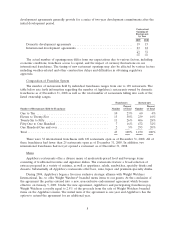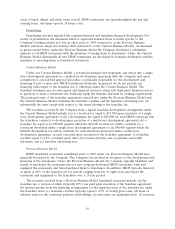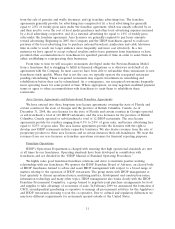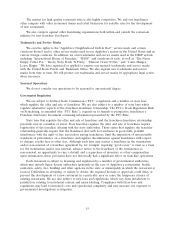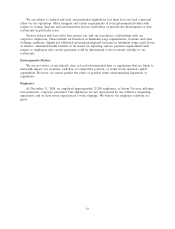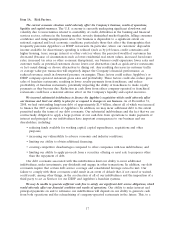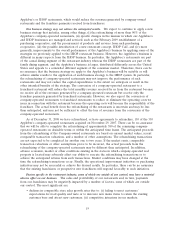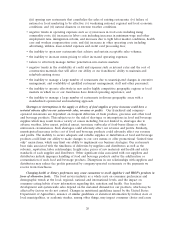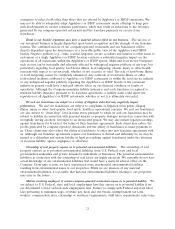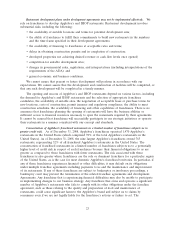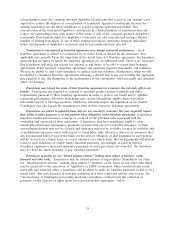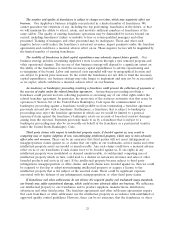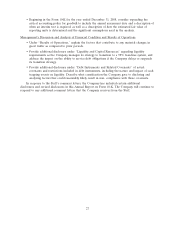IHOP 2008 Annual Report Download - page 31
Download and view the complete annual report
Please find page 31 of the 2008 IHOP annual report below. You can navigate through the pages in the report by either clicking on the pages listed below, or by using the keyword search tool below to find specific information within the annual report.Item 1A. Risk Factors.
The current economic situation could adversely affect the Company’s business, results of operations,
liquidity and capital resources. The U.S. economy is currently undergoing significant slowdown and
volatility due to uncertainties related to availability of credit, difficulties in the banking and financial
services sectors, softness in the housing market, severely diminished market liquidity, falling consumer
confidence and rising unemployment rates. Our business is dependent to a significant extent on
national, regional and local economic conditions, particularly those that affect the demographics that
frequently patronize Applebee’s or IHOP restaurants. In particular, where our customers’ disposable
income available for discretionary spending is reduced (such as by job losses, credit constraints and
higher housing, taxes, energy, interest or other costs) or where the perceived wealth of customers has
decreased (because of circumstances such as lower residential real estate values, increased foreclosure
rates, increased tax rates or other economic disruptions), our business could experience lower sales and
customer traffic as potential customers choose lower-cost alternatives (such as quick-service restaurants
or fast casual dining) or choose alternatives to dining out. Any resulting decreases in customer traffic
or average value per transaction will negatively impact the Company’s financial performance, as
reduced revenues result in downward pressure on margins. These factors could reduce Applebee’s or
IHOP company-operated restaurant gross sales and profitability. These factors could also reduce gross
sales of franchise restaurants, resulting in lower royalty payments from franchisees, and reduce
profitability of franchise restaurants, potentially impacting the ability of franchisees to make royalty
payments as they become due. Reduction in cash flows from either company-operated or franchised
restaurants could have a material adverse affect on the Company’s liquidity and capital resources.
We incurred substantial indebtedness to finance the Applebee’s acquisition which could adversely affect
our business and limit our ability to plan for or respond to changes in our business. As of December 31,
2008, we had outstanding long-term debt of approximately $1.9 billion, almost all of which was incurred
to finance the 2007 acquisition of Applebee’s. In addition, we may incur additional debt to the extent
permitted under the terms of our debt covenants. Our substantial indebtedness and the fact that we are
contractually obligated to apply a large portion of our cash flow from operations to make payments of
interest and principal on our indebtedness have important consequences to our business and our
shareholders, including:
• reducing funds available for working capital, capital expenditures, acquisitions and other
purposes;
• increasing our vulnerability to adverse economic and industry conditions;
• limiting our ability to obtain additional financing;
• creating competitive disadvantages compared to other companies with less indebtedness; and
• limiting our ability to apply proceeds from a securities offering or asset sale to purposes other
than the repayment of debt.
Our debt covenants associated with this indebtedness limit our ability to incur additional
indebtedness, make investments, pay dividends and engage in other transactions. In addition, our debt
covenants require that certain debt service coverage and consolidated leverage ratios be met. Our
failure to comply with these covenants could result in an event of default that, if not cured or waived,
could result, among other things, in the acceleration of all of our indebtedness and the imposition of a
third party to act as Servicer for our IHOP and Applebee’s franchise systems.
We may be unable to generate sufficient cash flow to satisfy our significant debt service obligations, which
would adversely affect our financial condition and results of operations. Our ability to make interest and
principal payments on and to refinance our indebtedness will depend on our ability to generate cash
from both operations and the refranchising of company-operated restaurants in the future. This, to a
17



